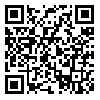Sun, Jun 29, 2025
[Archive]
Volume 38, Issue 1 (1-2024)
Med J Islam Repub Iran 2024 |
Back to browse issues page
Download citation:
BibTeX | RIS | EndNote | Medlars | ProCite | Reference Manager | RefWorks
Send citation to:



BibTeX | RIS | EndNote | Medlars | ProCite | Reference Manager | RefWorks
Send citation to:
Farhangniya M, Samadikuchaksaraei A, Mohamadi Farsani F. Exploring Co-expression Modules-Traits Correlation through Weighted Gene Co-expression Network Analysis: A Promising Approach in Wound Healing Research. Med J Islam Repub Iran 2024; 38 (1) :568-577
URL: http://mjiri.iums.ac.ir/article-1-9223-en.html
URL: http://mjiri.iums.ac.ir/article-1-9223-en.html
Cellular and Molecular Research Center, Faculty of Medicine, Iran University of Medical Sciences, Tehran, Iran & Health Metrics Research Center, Iranian Institute for Health Sciences Research, ACECR, Tehran, Iran , farhangniya.m@iums.ac.ir
Abstract: (776 Views)
Background: The skin is the biggest organ in the body and has several important functions in protection and regulation. However, wound development can disrupt the natural healing process, leading to challenges such as chronic wounds, persistent infections, and impaired angiogenesis. These issues not only affect individuals' well-being but also pose significant economic burdens on healthcare systems. Despite advancements in wound care research, managing chronic wounds remains a pressing concern, with obstacles such as persistent infection and impaired angiogenesis hindering the healing process. Understanding the complex genetic pathways involved in wound healing is crucial for developing effective therapeutic strategies and reducing the socio-economic impact of chronic wounds. Weighted Gene Co-Expression Network Analysis (WGCNA) offers a promising approach to uncovering key genes and modules associated with different stages of wound healing, providing valuable insights for targeted interventions to enhance tissue repair and promote efficient wound healing.
Methods: Data collection involved retrieving microarray gene expression datasets from the Gene Expression Omnibus website, with 65 series selected according to inclusion and exclusion criteria. Preprocessing of raw data was performed using the Robust MultiArray Averaging approach for background correction, normalization, and gene expression calculation. Weighted Gene Co-Expression Network Analysis was employed to identify co-expression patterns among genes associated with wound healing processes. This involved steps such as network construction, topological analysis, module identification, and association with clinical traits. Functional analysis included enrichment analysis and identification of hub genes through gene-gene functional interaction network analysis using the GeneMANIA database.
Results: The analysis using WGCNA indicated significant correlations between wound healing and the black, brown, and light green modules. These modules were further examined for their relevance to wound healing traits and subjected to functional enrichment analysis. A total of 16 genes were singled out as potential hub genes critical for wound healing. These hub genes were then scrutinized, revealing a gene-gene functional interaction network within the module network based on the KEGG enrichment database. Noteworthy pathways such as MAPK, EGFR, and ErbB signaling pathways, as well as essential cellular processes including autophagy and mitophagy, emerged as the most notable significant pathways.
Conclusion: We identified consensus modules relating to wound healing across nine microarray datasets. Among these, 16 hub genes were uncovered within the brown and black modules. KEGG enrichment analysis identified co-expression genes within these modules and highlighted pathways most closely associated with the development of wound healing traits, including autophagy and mitophagy. The hub genes identified in this study represent potential candidates for future research endeavors. These findings serve as a stepping stone toward further exploration of the implications of these co-expressed modules on wound healing traits.
Methods: Data collection involved retrieving microarray gene expression datasets from the Gene Expression Omnibus website, with 65 series selected according to inclusion and exclusion criteria. Preprocessing of raw data was performed using the Robust MultiArray Averaging approach for background correction, normalization, and gene expression calculation. Weighted Gene Co-Expression Network Analysis was employed to identify co-expression patterns among genes associated with wound healing processes. This involved steps such as network construction, topological analysis, module identification, and association with clinical traits. Functional analysis included enrichment analysis and identification of hub genes through gene-gene functional interaction network analysis using the GeneMANIA database.
Results: The analysis using WGCNA indicated significant correlations between wound healing and the black, brown, and light green modules. These modules were further examined for their relevance to wound healing traits and subjected to functional enrichment analysis. A total of 16 genes were singled out as potential hub genes critical for wound healing. These hub genes were then scrutinized, revealing a gene-gene functional interaction network within the module network based on the KEGG enrichment database. Noteworthy pathways such as MAPK, EGFR, and ErbB signaling pathways, as well as essential cellular processes including autophagy and mitophagy, emerged as the most notable significant pathways.
Conclusion: We identified consensus modules relating to wound healing across nine microarray datasets. Among these, 16 hub genes were uncovered within the brown and black modules. KEGG enrichment analysis identified co-expression genes within these modules and highlighted pathways most closely associated with the development of wound healing traits, including autophagy and mitophagy. The hub genes identified in this study represent potential candidates for future research endeavors. These findings serve as a stepping stone toward further exploration of the implications of these co-expressed modules on wound healing traits.
Type of Study: Original Research |
Subject:
Biotechnology
Send email to the article author
| Rights and permissions | |
 |
This work is licensed under a Creative Commons Attribution-NonCommercial 4.0 International License. |








